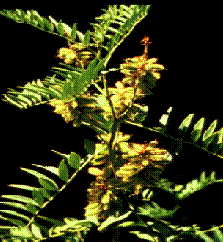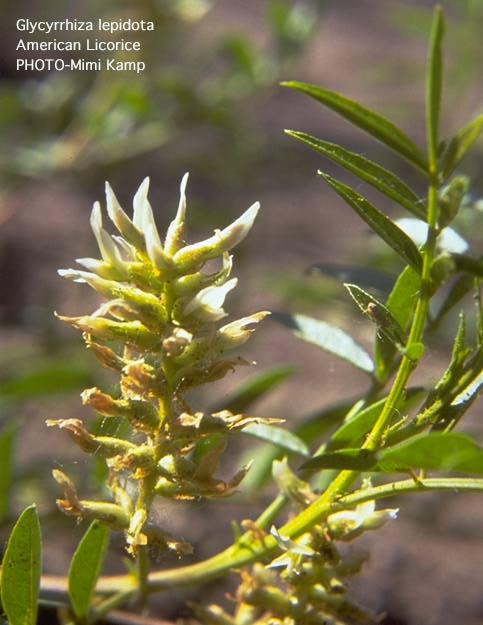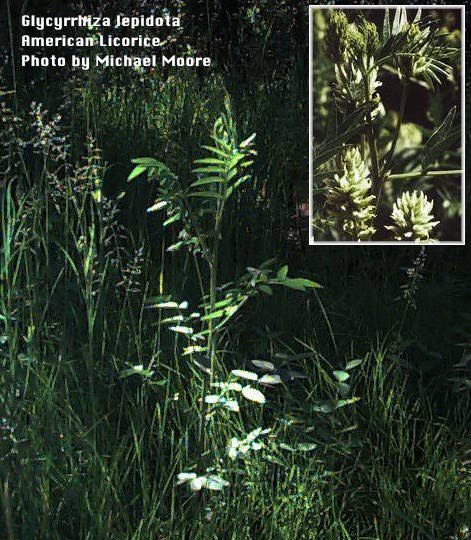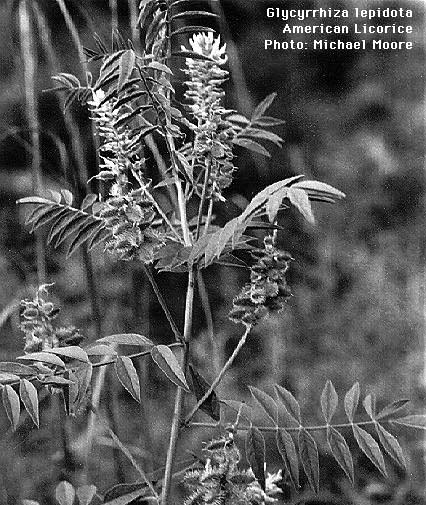Wild Licorice (Glycyrrhiza lepidota)

Found throughout North Dakota, wild licorice occurs from Minnesota west to Alberta and Washington and south to Texas and California at elevations up to 8,500 ft. Wild licorice is perennial from long, tough taproots and interconnected rootcrowns. Plants are hairless. They may grow three feet tall in southern states, but North Dakota plants usually are about 18 inches tall. Leaves are pinnate (arranged like two combs set back-to-back) and up to eight inches long. Each leaf bears 7-21 leaflets up to 1 1/2 inches long that have small scales when young. The scales soon change into sticky, resinous dots. About 10-20 pale, whitish-yellow flowers about 1/2 inch long are grouped into spikes about 2-3 inches long that arise in the middle and upper branches. The seeds are enclosed in dark brown pods (legumes) equipped with hooked prickles like the cocklebur.
Wild Licorice (Glycyrrhiza lepidota)
Look for wild licorice during May to August in rich soil areas in native prairie near wetlands or coulee bottoms. Grazing seems to have little effect on the density of this plant. Wild licorice was sometimes grown by Amerindians, who ate the sweet, slightly licorice-flavored roots. The roots contain up to 6% of the sweet substance, glycyrrhizin.
Wild licorice is a member of the economically important bean family (Fabaceae). Fab means bean in Latin. The generic name is from the Greek glycys, "sweet", and rhiza, "root". Lepidota means "scaly" in botanical Latin. There are about 15 species of Glycyrrhiza worldwide, but only one in the United States. Wild licorice was first described for science by Frederic Pursh in his monumental Flora Americae Septentrionale of 1814.
![]()
*
![]()

![]()

![]()
Licorice
Licorice is an ancient herb (Glycyrrhiza glabra) that has been used for medicinal purposes for centuries. Licorice (often spelled "liquorice" in ancient herbals) is a member of the legume family, whose cousins include beans, peas and the herb broom. About two-thirds of all Chinese herbal formulas include licorice.
Licorice is a popular remedy for cough, some complications of tuberculosis, and chest complaints in general, such as bronchitis. Because of its soothing properties, it often is used in cough medicines. It is also highly regarded as a soothing ingredient for sore throat and laryngitis. The Chinese have also used licorice to strengthen and balance the female reproductive system. Some compounds found in licorice are thought to help the adrenal glands function more smoothly in conditions of stress and exhaustion. The adrenal glands are responsible for hormones that keep the body systems balanced. Naturopaths have used licorice in treating hypoglycemia, diabetes and Addison's disease, which is a malfunction of the adrenal glands.
At the IX International Conference on AIDS in Berlin, two small, non- randomized studies of glycyrrhizin in asymptomatic HIV+ individuals suggested some benefits to the treatment. However, these studies, both of which were conducted in Japan, are difficult to analyze or draw any conclusions from, due to the small size and the extremely limited data that were published. There are reports of glycyrrhizin causing high blood pressure, water retention, and possibly heart complications when taken in very high doses.
Naturally sweet licorice root has been used for thousands of years to treat coughs, lung congestion, constipation and relieve inflammation of mucus membranes. The Greeks wrote about it over 2,300 years ago, and extract from the roots of glycyrrhizin has been used throughout Europe. For over forty years, it's been a prescription drug in Japan to treat inflammatory illnesses such as ulcers and chronic liver disease. It is also used to decrease allergic reactions to other drugs.
The chief substance in licorice root, which supplies the sweet taste, is called glycyrrhizin. Glycyrrhizin is a sweet, white crystalline powder consisting of the calcium and potassium salts of glycyrrhizic acid. Other substances found in the root include starch, gum, protein, fat, resin, asparagin, a trace of tannin, yellow coloring matter and a small amount of volatile oil.
Candy called licorice is flavored mostly with anise (another plant, a part of the parsely family), and has very little glycyrrhizin in it. Some natural licorice candies and cough drops can be found in health-food stores. Glycyrrhizin may protect livers and other vital organs from being damaged by oxidants. Too many oxidants can harm healthy cells and cause inflammation. Licorice is considered ideal for patients who are dehydrated or thin, but not for people with swelling, pregnant women in the last trimester, or people who are overweight because of water retention.
Also, to be safe, if you have high blood pressure or heart trouble, avoid large amounts of licorice. The overconsumption of candies containing licorice extract has caused some people to develop symptoms of edema, or swelling, and related problems. Large amounts of licorice should be avoided since the herb can deplete your body of potassium, causing an electrolyte imbalance.
Licorice grows wild in North America as Glycyrrhiza lepidota, one of numerous species of this plant. The Blackfoot Indians of the Dakotas steeped the leaves of wild licorice plants in hot water and used this infusion to treat earache. In China, where licorice is commonly called gan cao (sweet weed), doctors have long used the herb for gastric ulcers and arthritis.
Researchers using a highly refined licorice extract suggest that chemicals in glycyrrhizin called triterpenoids may be effective against cancer. They may block the production of prostaglandin - a hormonelike fatty acid that may be responsible for stimulating the growth of cancer cells - and help get rid of cancer-causing invaders. Triterpenoids have been shown in test tubes to stunt the growth of rapidly multiplying cells, like cancer cells, and they may even help precancerous cells return to normal.
![]()
The Silver-Spotted Skipper Epargyreus clarus (Cramer), 1775 Habitat: Sunlit wooded clearings; Apocynum blooms Larval food: Wild licorice (Glycyrrhiza lepidota)
![]()
 Wildflower
Seed For Sale
Wildflower
Seed For Sale